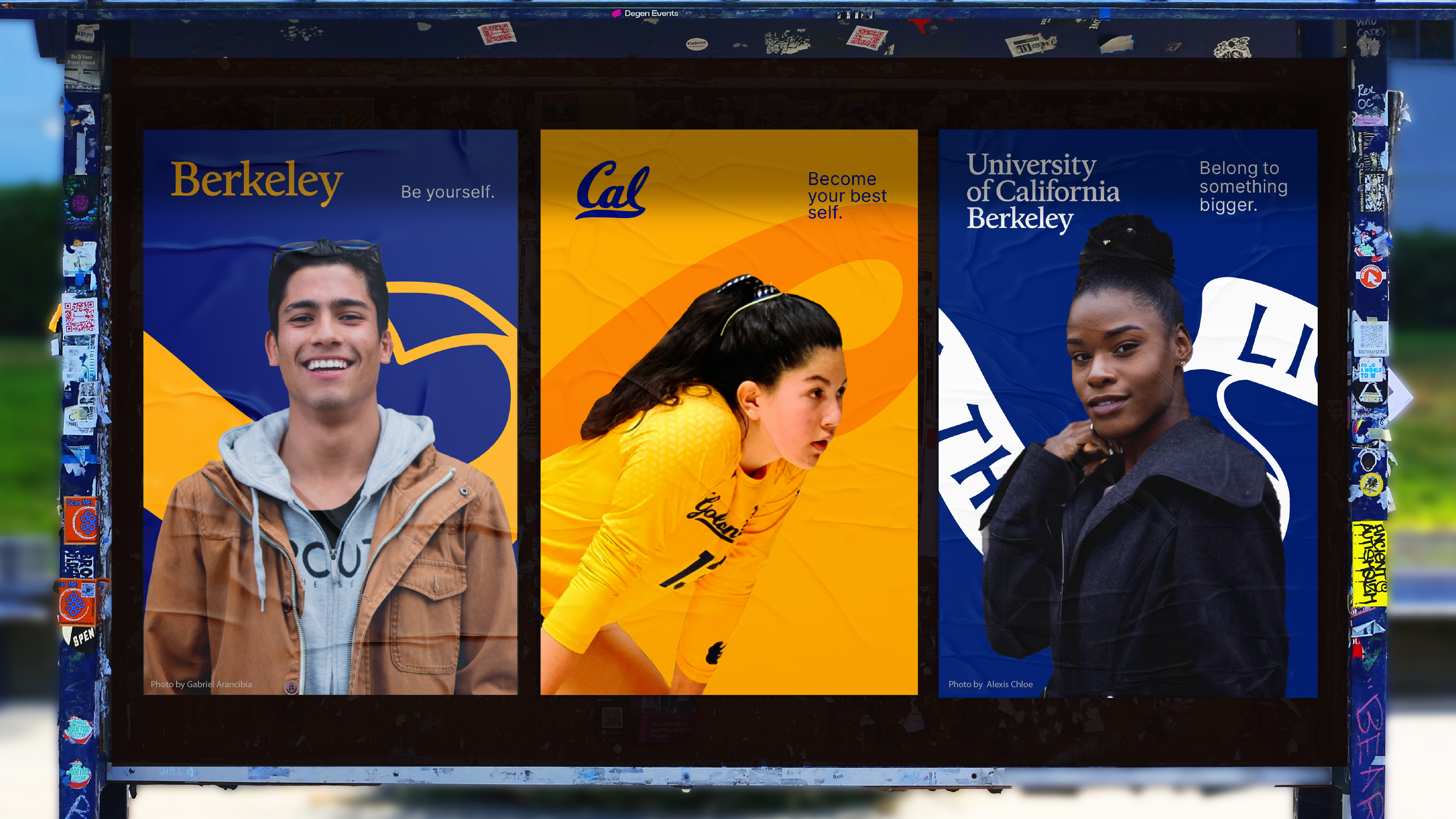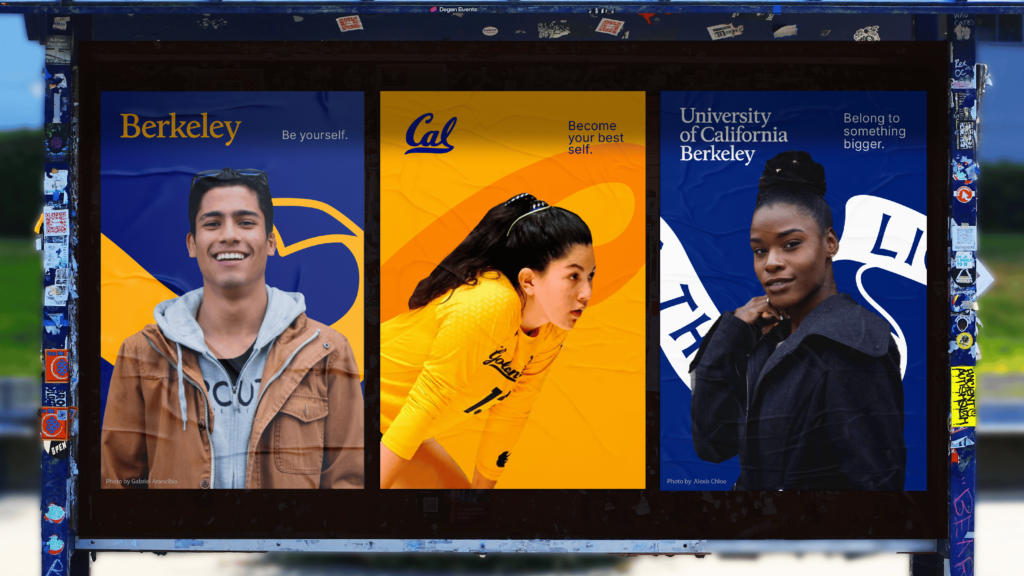Brand identity update
A new toolkit will allow the Berkeley and Cal identities to coexist in an interconnected ecosystem.

Berkeley. Cal. California. UC Berkeley. For many with strong ties, these are all synonyms for the world’s premier public university. However, more than one-quarter of the people living in the San Francisco Bay Area are unaware that Berkeley and Cal are the same university. The situation gets worse the farther you get from the Bay Area. Nationally, more than two-thirds of people think Berkeley and Cal are different institutions.
After reviewing these and other research findings, the Berkeley/Cal Identity Task Force made several recommendations to enhance clarity, elevate community and communicate the breadth of the campus’ offerings and comprehensive excellence.
In response to the task force’s recommendations, the campus is implementing an updated visual identity toolkit inclusive of both the Berkeley and Cal identities. While shifting the athletics identity to Cal Berkeley will not be adopted, other changes are reflected in this visual identity update.
Our inclusive process
Over nearly two years, representatives from key campus constituencies, including alumni, faculty, staff and students, guided this inclusive and thorough process. In addition to bringing their own experiences and expertise to the project, the task force and committee members considered the feedback shared by the campus community and the extensive research conducted for this project.
Qualitative and quantitative research
Our visual identity
The Berkeley and Cal identities have been redefined to enhance clarity and elevate community. Whereas in the past, connections were discouraged, the new visual identity envisions an interconnected ecosystem where Berkeley and Cal complement each other.

Primary logos
The Cal logo is unchanged, preserving its rich history and tradition. The Berkeley logo is being updated to address issues with legibility at small sizes, usability in digital environments, and incompatibility between the two logos while maintaining the equity built over generations.
The Berkeley logo is based on the University of California Old Style typeface created by Frederic Goudy for the University of California Press. The typeface is also known as Berkeley Old Style and Californian. Over the years, the Berkeley logo has evolved while maintaining its connection to the Goudy typeface.
The new iteration of the typeface has evolved to perform better in digital spaces by lessening the contrast of the letterforms. This means that the difference between the thickest and thinnest parts of the characters has been reduced, resulting in better legibility.
The new Berkeley logo draws inspiration from the original metal version of the typeface and other Goudy works. It retains the visual equity of the existing logo while functioning as a believable system with the Cal logo.

Secondary brand assets
The Berkeley seal hasn’t been changed. It is an important part of our heritage and reinforces our legacy of leadership. The guidelines for using the seal, the bear, and other brand assets are being updated to support our legacy and community building.

Color palette
For the past decade, academics and athletics have used different color palettes. Moving forward, the traditional “Berkeley Blue” and “California Gold” will be used in all contexts. Berkeley Blue has been brightened to better match the saturation of California Gold. An updated simplified secondary color palette will complement the primary blue and gold.

Typography
The standard use of two new typefaces, Inter and Source Serif, will provide additional opportunities for visual connection. Both typefaces are released under open-source licenses and available for free through Google Fonts.

Graphic elements
The new brand visual identity includes updated graphic elements inspired by existing brand elements. These include an optimized version of the Berkeley seal, which can now be used in additional ways, including as a supergraphic, and other components pulled from aspects of the seal and Cal logo.
FAQ
The university has two distinct identities for academics and athletics, including separate logos, color palettes, typography and graphic elements, and guidelines that prevent the connection of the two identities and that restrict the use of Cal and “bears” for non-Intercollegiate Athletics units. This has led to a lack of understanding of the institution’s breadth, independent associations formed with each name, and a hampered sense of belonging and inclusion on campus.
These changes aim to better communicate the breadth of Berkeley’s excellence while continuing to honor Cal as an important part of the university’s identity and history.
These changes result from a nearly two-year process that concluded in the spring. The exact timing of the rollout was chosen based on the academic calendar to minimize disruption and confusion. By launching the changes immediately following commencement season, the new visual identity can consistently be used throughout the 2024-2025 admissions cycle and in other key communications timed with the academic year.
The system for how school, college and department names will be displayed next to the Berkeley logo is still being finalized. The goal is to finalize these changes by mid summer. Units will be provided a generous timeline for implementing these changes according to what works best for their specific needs.
Berkeley was founded as the University of California in 1868. In 1952, the Regents reorganized the university into a system of semi-autonomous campuses. While Berkeley has held on to traditions stemming from the first 84 years of its history, including the use of the names California and Cal in athletics and school spirit contexts, the University of California is now a 10-campus university system of which Berkeley is one part.
Berkeley and UCLA share U.S News and World Report’s #1 public university ranking. Eight of the 10 campuses are members of the distinguished Association of American Universities. No other university system has this distinction.
Over the years, the flagship’s reputation for academic prestige has shifted to be more closely aligned with the Berkeley identity. Research found that people are 2 to 3 times more likely to associate Berkeley with excellence across several traits associated with universities than Cal.
As the flagship of the University of California, UC will always be an important part of Berkeley’s identity. The previous version of the Berkeley logo released in 2013 had two versions: one with “University of California” in small type under the word Berkeley and a simplified version without mention of the University of California. In practice, the simplified version was used most often.
The new visual identity maintains two versions: a primary academic logo (”Berkeley”) and a secondary extended logo (“University of California Berkeley”) for use when the connection to the UC is unclear.
No. The Cal logo is unchanged, preserving its rich history and tradition.
No. “Fight for California” remains our fight song. Cal and California remain an important part of our identity and traditions.
The new social media icon is the first letter of the Berkeley logo, creating a clear visual connection between the two. The B monogram is only intended for small spaces where the Berkeley logo would be hard to read. The new social media icon is not a logo and does not replace the Berkeley or Cal logos.
Berkeley is the primary identity of the university. Using “Cal” or “C,” which is the identity for athletics, as a shorthand for “Berkeley” would be confusing and further dilute the university’s brand and reputation. The new visual identity and brand guidelines are designed to strengthen ties between the Berkeley and Cal identities in other ways.
Bk is the symbol for the 97th element, Berkelium. While first produced in 1949 at UC Berkeley, the element is named after the city of Berkeley. The symbol was previously allowed for use as a social media icon but we have since found that it contributes to further brand confusion.
The seal is highly intricate and becomes indiscernible at small sizes, such as when used as a social media icon. Furthermore, the seal is a shared asset across the entire UC system, with minor changes for each campus. For these reasons, the seal is not the most distinguishing element as a social media icon. Instead, the new guidelines expand the use of the seal in new and exciting ways that allow its beauty to be fully showcased.
The B monogram, while new now, has a clear visual connection to the Berkeley logo and the academic prestige associated with the university. It is common for highly-regarded brands to use an initial from their name as their social media icon. Some notable examples include The New York Times, Dartmouth, and Yale.

